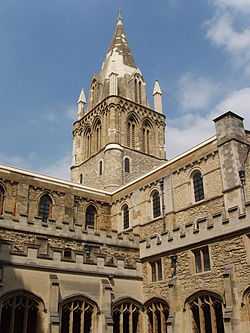Christ Church Cathedral, Oxford
| Christ Church Cathedral | |
|---|---|
| Cathedral Church of Christ | |
|
The Crossing Tower and Spire from the Cloisters. | |
| 51°45′00″N 1°15′17″W / 51.75°N 1.254722°WCoordinates: 51°45′00″N 1°15′17″W / 51.75°N 1.254722°W | |
| Location | Oxford, Oxfordshire |
| Country | England |
| Denomination | Church of England |
| Website | chch.ox.ac.uk/cathedral |
| Architecture | |
| Style | Romanesque, Gothic |
| Years built | 1160–1200 |
| Administration | |
| Diocese | Oxford (since 1546) |
| Province | Canterbury |
| Clergy | |
| Dean | The Very Revd. Professor Martyn Percy |
| Subdean | The Rev'd Canon Edmund Newey |
| Canon(s) |
George Pattison, Lady Margaret Professor of Divinity Nigel Biggar, Regius Professor of Moral and Pastoral Theology Sarah Foot, Regius Professor of Ecclesiastical History (Lay) Angela Tilby, Diocesan Canon |
Christ Church Cathedral is the cathedral of the diocese of Oxford, which consists of the counties of Oxfordshire, Buckinghamshire and Berkshire. It also acts as chapel for Christ Church College at the University of Oxford. This dual role as college chapel and cathedral is unique.
History

The cathedral was originally the church of St Frideswide's Priory. The site is claimed to be the location of the abbey and relics of St Frideswide, the patron saint of Oxford, although this is debatable.
In 1522, the priory was surrendered to Cardinal Wolsey, who had selected it as the site for his proposed college. However, in 1529 the foundation was taken over by King Henry VIII. Work stopped, but in June 1532 the college was refounded by the King. In 1546, Henry VIII transferred to it the recently created see of Oxford from Osney. The cathedral has the name of Ecclesia Christi Cathedralis Oxoniensis, given to it by King Henry VIII's foundation charter.
There has been a choir at the cathedral since 1526, when John Taverner was the organist and also master of the choristers. The statutes of Cardinal Wolsey's original college, initially called Cardinal College, mentioned sixteen choristers and thirty singing priests.
Christ Church Cathedral is often claimed to be the smallest cathedral in England, and although it did once hold this distinction there are now smaller cathedrals, as several parish churches were elevated to cathedral status in the 20th century.[1]
The nave, choir, main tower and transepts are of the late Norman period. There are architectural features ranging from Norman to the Perpendicular style and a large rose window of the ten-part (i.e., botanical) type.
Dean and Chapter
- Dean – The Very Revd. Professor Martyn Percy (since 4 October 2014 installation)
- Sub-Dean – The Revd Canon Dr Ed Newey (since 3 August 2013 installation)[2]
- Regius Professor of Divinity (Canon Residentiary) - The Revd Canon Prof Graham Ward[3]
- Lady Margaret Professor of Divinity (Canon Residentiary) – The Revd Canon Prof George Pattison (since 18 January 2004 installation)[4]
- Regius Professor of Moral and Pastoral Theology (Canon Residentiary) – The Revd Canon Prof Nigel Biggar (since 6 October 2007 installation)[5]
- Regius Professor of Ecclesiastical History (Canon Residentiary) – Canon Prof Sarah Foot (since 6 October 2007 installation)[5]
- Continuing Ministerial Development Advisor (Diocesan Canon) – The Revd Canon Angela Tilby (since November 2011)
Music
Organ
The organ is a 43-rank, four-manual and pedal instrument built in 1979 by Austrian firm Rieger Orgelbau.[6]
Organists
First among the notable organists of Oxford Cathedral is the Renaissance composer John Taverner. Other significant composers and conductors are Basil Harwood, Thomas Armstrong, Simon Preston and Nicholas Cleobury.
Choirs
The main choir, Christ Church Cathedral Choir consists of 12 men (6 professional 'lay-clerks' and 6 student 'academical clerks') and 16 choristers (boys aged 7 – 13), and is directed by Dr Stephen Darlington. They sing in University term time, at Christmas and Easter, and have an extensive touring and recording programme.
The Cathedral Singers consists of volunteers and is directed by John Padley. They are usually in residence outside of term time when the main choir choristers and academical clerks are on holiday.
The College choir sings every 1–2 weeks in term time, and is made up of current undergraduates and postgraduates from the College.
Notable burials

- Robert Burton (author The Anatomy of Melancholy)
- Bishop George Berkeley, philosopher (his memorial is in the nave)
- John Fell, Bishop of Oxford
- Sir Henry Gage (1593–1645), buried in the Lucy Chapel off the south transept
- Henry Liddell, father of Alice Liddell
- John Locke, famous philosopher
- Lady Elizabeth Montacute
- John de Nowers
- George Stewart, 9th Seigneur d'Aubigny, Cavalier
- Thomas Banks Strong, Bishop of Oxford
- John Underhill (bishop)
- John Urry
- Sir Peter Wyche, ambassador to the Ottoman Empire and member of the Privy Council
Gallery
-

View of the cathedral
-

Inside Christ Church Cathedral
-

The altar and vault
-

Altar
-

Nave
-
Cloisters
-
Ceiling
-
Tomb of John de Nowers
-
Stained glass window
See also
- List of cathedrals in the United Kingdom
- Christ Church, Oxford: more information on the College and the Cathedral
- Bishop of Oxford
- Diocese of Oxford
- Architecture of the medieval cathedrals of England
- English Gothic architecture
- Romanesque architecture
- Church of England
References
- ↑ Christ Church Cathedral — Miscellany, Archive.org, 2004.
- ↑ Christ Church – Appointment of new Sub Dean
- ↑ http://www.chch.ox.ac.uk/cathedral/whos-who/dean-chapter-staff
- ↑ Anglican Communion News Service – American Canon to English post
- ↑ 5.0 5.1 Christ Church – Welcome for Canon Professors
- ↑ National Pipe Organ Register Oxford Cathedral
External links
| Wikimedia Commons has media related to Christ Church Cathedral, Oxford. |
- Christ Church Cathedral website
- Christ Church Cathedral Choir website
- Oxford Cathedral information
- A history of the choristers of Christ Church Cathedral, Oxford
- Sacred destinations photo gallery
| ||||||||||||||||||




